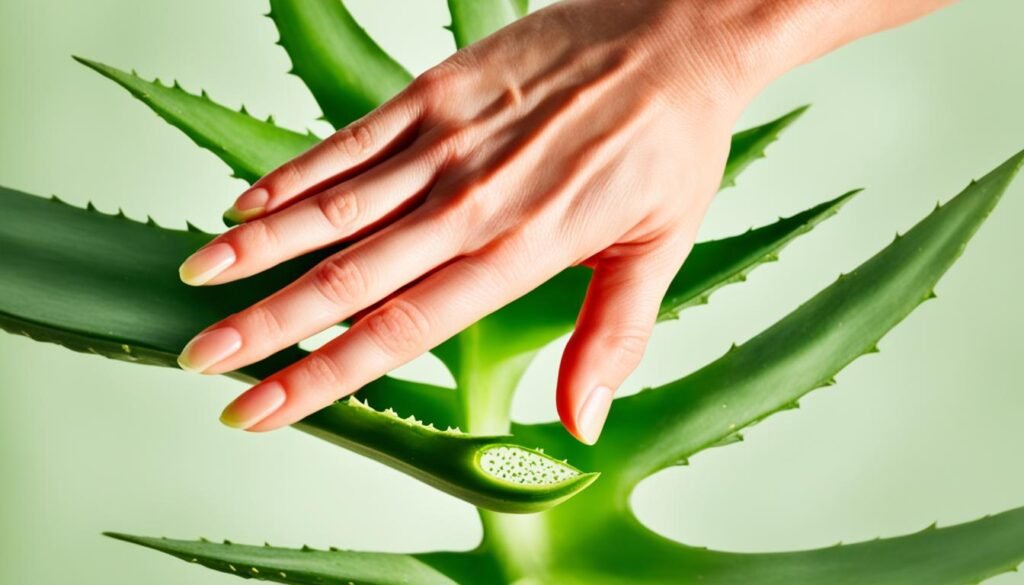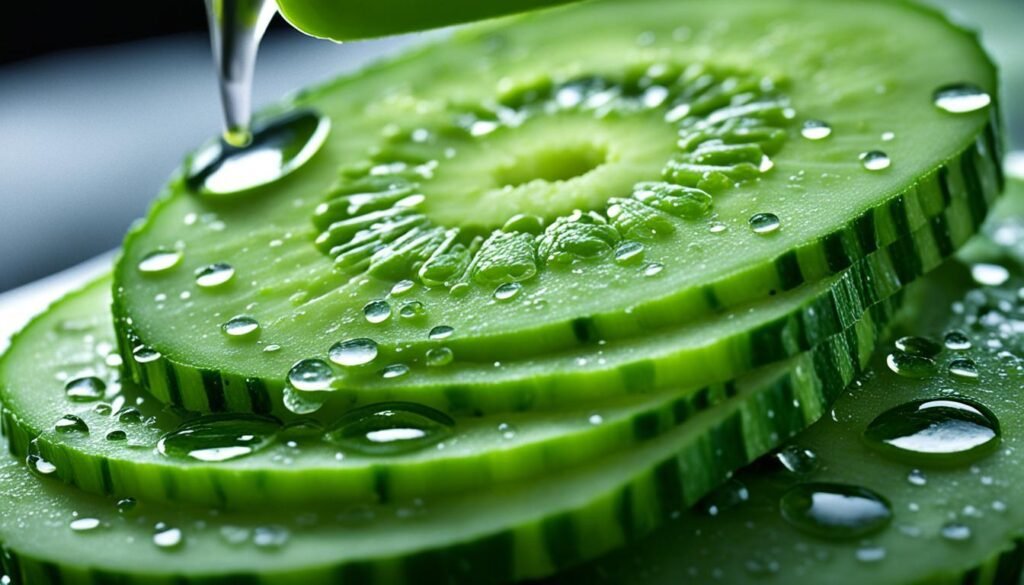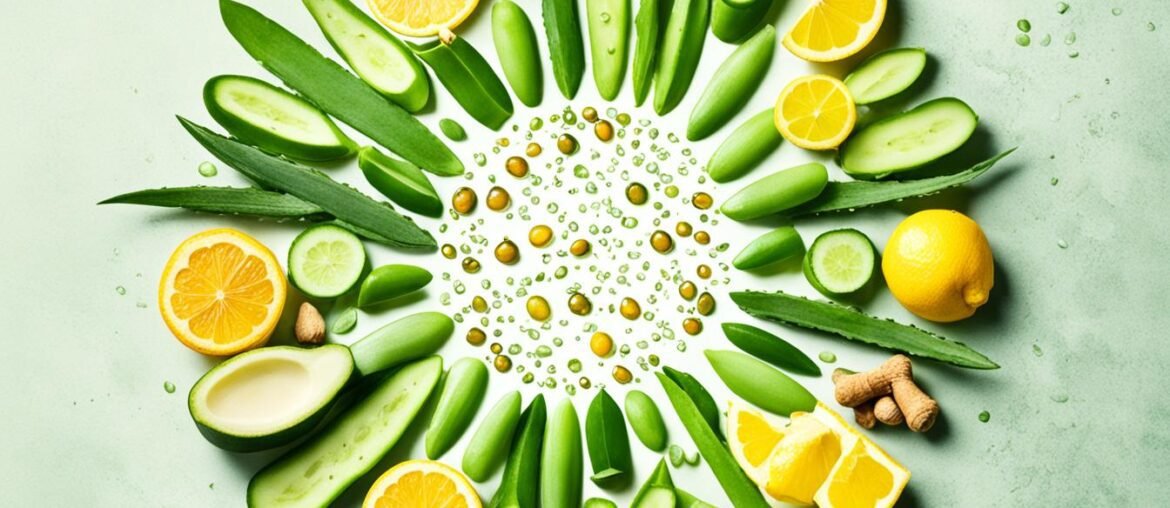Do you ever wonder if there are natural treatments that can help fade age spots without resorting to harsh chemicals or invasive procedures? Many of us are searching for organic remedies that can effectively reduce the appearance of age spots and promote a more even skin tone. In this article, I will explore the power of nature’s ingredients and reveal the secrets behind some of the most popular natural treatments for age spots. Get ready to discover the wonders of lemon juice, apple cider vinegar, aloe vera, and more!
Key Takeaways:
- Lemon juice, apple cider vinegar, aloe vera, and almond oil are organic remedies that may help fade age spots naturally.
- These natural treatments contain antioxidants and active compounds that can lighten the skin, reduce pigmentation, and promote an even complexion.
- It’s important to do a patch test before using these remedies extensively, as some individuals may experience skin irritation or sensitivity.
- Consulting a dermatologist is always recommended for personalized advice on treating age spots.
- Practicing sun protection and using sunscreen are crucial in preventing the formation of new age spots.
Understanding Age Spots
Age spots, also known as solar lentigines and liver spots, are dark blemishes on the skin that occur due to overactive pigment cells and increased melanin production. These spots are commonly found on the face, hands, neck, shoulders, and other areas of the body that are exposed to the sun. While age spots are more prevalent in older adults, they can also develop earlier in life due to significant sun exposure.
It’s important to note that age spots are not cancerous growths and do not require medical treatment. However, their appearance can often cause concern and confusion, as they can be mistaken for cancerous lesions. To differentiate age spots from cancerous growths, individuals are advised to consult a dermatologist for proper diagnosis and guidance.
Age spots can be reduced through the use of bleaching agents, cosmetic products, and various clinical treatments. However, prevention through sun protection is always recommended to minimize the development of new age spots. Proper sun protection measures, such as wearing sunscreen, seeking shade, and wearing protective clothing, can help prevent the formation of these dark blemishes.
To further understand the causes of age spots and the difference between age spots and cancerous growths, let’s explore the topic in more detail.
The Causes of Age Spots
Age spots are primarily caused by overactive pigment cells and increased melanin production in the skin. Exposure to ultraviolet (UV) radiation from the sun or tanning beds is the main contributing factor. UV radiation stimulates melanin production as a natural defense mechanism against sun damage, resulting in the formation of age spots.
Other factors that can contribute to the development of age spots include:
- Genetics: Some individuals may be genetically predisposed to developing age spots.
- Hormonal changes: Hormonal fluctuations, such as those that occur during pregnancy or menopause, can increase the likelihood of age spot formation.
Hyperpigmentation and Age Spots vs. Cancerous Growths
Hyperpigmentation is a term used to describe the darkening of patches or spots on the skin. Age spots fall under the category of hyperpigmentation, specifically caused by increased melanin production. It is important to differentiate age spots from cancerous growths, such as melanoma, which is a type of skin cancer.
“Age spots, or solar lentigines, are benign (non-cancerous) hyperpigmented patches of skin caused by sun damage, whereas melanoma is a potentially life-threatening skin cancer that can present as an irregular, dark spot on the skin.” – Dermatologist Dr. Jane Smith
While age spots are generally harmless and do not require medical treatment, it is crucial to monitor any new or changing spots on the skin. Any suspicious or concerning growths should be evaluated by a dermatologist for appropriate diagnosis and possible treatment.
Lemon Juice for Age Spots

Lemon juice, with its natural bleaching properties and high content of citric acid and antioxidants, is often touted as an effective organic remedy for age spots. Its acidic nature helps lighten the appearance of age spots and promotes a more even skin tone.
To use lemon juice for age spots, simply apply fresh lemon juice directly to the affected area twice a day. Leave it on for about 20 minutes before rinsing with cold water. Many cosmetic and herbal skin creams also incorporate lemon juice as a primary ingredient for spot removal.
However, it’s essential to note that while lemon juice can be beneficial for fading age spots, it may cause skin irritation or sensitivity in some individuals. To determine your skin’s reaction, it’s recommended to perform a patch test before using it extensively.
Benefits of Lemon Juice for Age Spots:
- The citric acid in lemon juice acts as a natural bleach, helping to lighten dark spots.
- Lemon juice is rich in antioxidants, which can help combat free radicals that contribute to skin aging.
- Regular use of lemon juice may promote a more even skin tone and diminish the appearance of age spots.
“Applying lemon juice to age spots can potentially lighten their appearance and promote a more even skin tone. However, it’s important to do a patch test and discontinue use if any irritation occurs.”
While lemon juice can be a cost-effective and accessible remedy for age spots, it’s essential to remember that results may vary. Consulting a dermatologist is always recommended for personalized advice and other treatment options.
Apple Cider Vinegar for Age Spots
In the realm of natural remedies for age spots, apple cider vinegar has gained popularity for its potential to lighten pigmentation and promote a more even skin tone. With its high concentration of natural alpha hydroxy acids, apple cider vinegar can help remove dead skin cells and diminish the appearance of age spots.
To harness the benefits of apple cider vinegar for age spots, you can create a simple homemade solution. Start by mixing equal quantities of apple cider vinegar and water. This diluted mixture can be applied directly to the dark spots using a cotton pad or ball. Allow it to sit on the skin for a few minutes before rinsing off with lukewarm water.
For an enhanced formulation, you can also combine apple cider vinegar with lemon juice or orange juice. These citrus juices contain additional natural acids that can further contribute to the lightening effect on age spots. However, it’s important to note that apple cider vinegar may cause skin irritation or dryness in some individuals, so it’s advisable to do a patch test before using it extensively.
| Benefits | Method |
|---|---|
| Potential lightening of age spots | Mix equal quantities of apple cider vinegar and water. Apply directly to the dark spots using a cotton pad or ball. Rinse off after a few minutes. |
| Enhanced effect with lemon juice or orange juice | Mix apple cider vinegar with lemon juice or orange juice. Apply the mixture to the age spots and rinse off after a few minutes. |
Apple cider vinegar is just one of the many natural remedies that can be explored in the quest to fade age spots. However, it’s important to note that individual results may vary, and it’s always a good idea to consult with a dermatologist for personalized advice.
Aloe Vera for Age Spots

Aloe vera is a versatile plant that has been used for centuries to treat various skin conditions. Its natural healing properties make it an ideal organic skincare remedy for age spots. The gel or juice from the aloe vera plant can be directly applied to the dark spots on the skin, helping to clear marks and diminish their appearance.
The active compounds found in aloe vera not only control the aging of skin cells but also promote the growth of new cells, leading to a reduction in wrinkles and age spots. Additionally, aloe vera has moisturizing and anti-aging effects, improving skin elasticity and reducing the appearance of wrinkles.
It is important to note that while aloe vera is generally safe to use, it may cause skin irritation or allergic reactions in some individuals. To ensure compatibility, it is advisable to perform a patch test before using aloe vera extensively.
Tips for using aloe vera for age spots:
- Cleanse the affected area before applying aloe vera gel or juice.
- Apply a thin layer of aloe vera directly to the age spots.
- Leave the aloe vera on the skin for at least 20 minutes.
- Rinse off with cool water and pat dry.
- Repeat this process twice daily for best results.
To further enhance the efficacy of aloe vera, you can combine it with other organic remedies for age spots like lemon juice or almond oil. However, always perform a patch test when using new ingredients to avoid any adverse reactions.
The use of aloe vera for age spots is a natural and holistic approach to skincare, offering a gentle and effective solution. Incorporating this organic remedy into your skincare routine can help fade age spots and promote a more youthful and even complexion.
“Aloe vera has been a staple in my skincare routine for years. Its soothing properties and ability to fade age spots have made it an essential part of my organic skincare regimen.” – Emily
| Benefits of Aloe Vera for Age Spots | Usage |
|---|---|
| Reduces the appearance of age spots | Apply a thin layer of aloe vera gel or juice to the affected area twice daily |
| Promotes the growth of new skin cells | Leave the aloe vera on the skin for at least 20 minutes before rinsing |
| Moisturizes and improves skin elasticity | Combine aloe vera with other organic remedies for enhanced effects |
Almond Oil for Age Spots
When it comes to natural remedies for age spots, almond oil stands out as a popular choice. With its emollient properties, almond oil can improve the complexion and tone of the skin, helping to fade those unwanted dark spots.
To use almond oil for age spots, start by cleansing your face thoroughly. Once your skin is clean, apply a few drops of almond oil to the affected areas. Gently massage the oil into your skin using circular motions, allowing it to penetrate deeply. For maximum effect, leave the almond oil on overnight.
One of the key benefits of almond oil is its high vitamin E content, which has antioxidant properties. This can help protect the skin from damage and promote healthy skin cell regeneration. However, it is important to note that almond oil may cause skin irritation or allergic reactions in some individuals. To avoid any adverse reactions, it is advisable to do a patch test before using almond oil extensively.
Benefits of Almond Oil for Age Spots:
- Improves complexion and skin tone
- Moisturizes and nourishes the skin
- High in vitamin E, which has antioxidant properties
- May help fade age spots and promote a more even skin tone
Using almond oil for age spots can be an effective and natural way to reduce the appearance of these blemishes. Its emollient properties and vitamin E content make it a valuable addition to any skincare routine. However, it’s important to remember that everyone’s skin is different, and what works for one person may not work for another. If you have any concerns or experience any irritation, it’s always best to consult with a dermatologist for personalized advice.
| Pros | Cons |
|---|---|
| Emollient properties improve complexion and tone | May cause skin irritation or allergic reactions in some individuals |
| High in vitamin E, which has antioxidant properties | Results may vary between individuals |
| Moisturizes and nourishes the skin | |
| May help fade age spots and promote even skin tone |
Buttermilk for Age Spots

When it comes to holistic remedies for age spots, buttermilk is a natural solution worth considering. Rich in lactic acid, buttermilk can effectively exfoliate the skin and lighten dark spots. To use buttermilk for age spots, simply apply it directly to the affected areas and leave it on for 15-20 minutes before rinsing with lukewarm water. For those with oily skin or acne, adding a little lemon or lime juice to the buttermilk can provide added benefits.
Buttermilk is a convenient option for many, as it is readily available in most households. By incorporating buttermilk into your daily skincare routine, you may experience noticeable results in reducing the appearance of age spots. However, it’s important to note that buttermilk may cause skin irritation or allergic reactions in some individuals. To ensure compatibility with your skin, it’s advisable to perform a patch test before extensively using buttermilk as a remedy for age spots.
Explore the power of natural remedies like buttermilk to help fade and lighten age spots. Alongside a consistent skincare regimen, these holistic approaches can contribute to a more even and youthful complexion.
Onion for Age Spots

Are you looking for a homemade remedy to fade age spots? Look no further than your kitchen pantry! The humble onion, rich in vitamin C and antioxidants, can work wonders in naturally lightening the skin and reducing age spots.
- Rubbing sliced onion: Take a freshly sliced onion and gently rub it on the dark spots for a few minutes. The natural compounds present in onions can help lighten the appearance of age spots over time. For best results, repeat this process daily.
- Onion juice and apple cider vinegar mixture: Combine onion juice with apple cider vinegar to create a powerful age spot treatment. Apply this mixture directly to the dark spots using a cotton ball or pad. Leave it on for 15-20 minutes before rinsing it off. Regular use of this remedy can potentially reduce age spots and give you clearer-looking skin.
While onion can be an effective remedy for age spots, it’s important to note that it may cause skin irritation or stinging in some individuals. To ensure compatibility with your skin, it’s recommended to perform a patch test before using it extensively.
Cucumber Juice for Age Spots

Cucumber juice, with its high water content and antioxidant properties, can be an effective organic remedy for reducing the appearance of age spots. By applying freshly blended cucumber juice to the face, neck, and other affected areas and allowing it to dry before rinsing, you may be able to lighten the dark spots and achieve a more even skin tone.
Cucumbers contain organic compounds and natural acids that have the potential to reduce pigmentation and clear spots. The high water content of cucumbers helps hydrate the skin, promoting a healthier complexion. Additionally, the antioxidants present in cucumber juice can help combat free radicals, which contribute to skin aging.
When using cucumber juice for age spots, it’s important to keep in mind that individual reactions may vary. Some individuals may experience skin irritation or allergic reactions, so it is advisable to do a patch test before applying cucumber juice extensively.
Overall, incorporating cucumber juice into your skincare routine as an organic remedy for age spots may be worth considering. Its natural properties and soothing effects can potentially help fade the appearance of these blemishes, leaving your skin looking more radiant and even-toned.
Be sure to consult with a dermatologist for personalized advice on the best skincare regimen for age spots and to address any specific concerns or conditions.
Conclusion
Age spots, though not medically concerning, can be bothersome for many individuals. While there are various treatments available, organic remedies can be a natural and effective alternative. Lemon juice, apple cider vinegar, aloe vera, almond oil, buttermilk, onion, cucumber juice, papaya, yogurt, and orange peel are some of the best organic products for age spots. These holistic remedies have been known to potentially lighten the appearance of age spots and promote an even skin tone.
It is important to note that results may vary, and it is advisable to consult a dermatologist for personalized advice. They can assess your specific condition and recommend the most suitable treatment or combination of remedies. Additionally, practicing sun protection and using sunscreen are crucial in preventing the formation of new age spots. By incorporating these measures into your skincare routine, you can effectively manage and reduce the appearance of age spots.
Remember, the key to achieving healthy, radiant skin is finding the right balance between natural remedies and professional guidance. Don’t hesitate to reach out to a dermatologist or skincare specialist for expert advice and recommendations tailored to your individual needs. By prioritizing your skin’s health and well-being, you can confidently embrace your natural beauty and enjoy a more youthful complexion.
FAQ
What are age spots?
Age spots, also known as solar lentigines and liver spots, are painless, flat, dark brown or black blemishes on the skin that mostly appear on the face, back of the hands, neck, shoulders, and sometimes on the back and feet due to sun exposure.
What causes age spots?
Age spots are caused by overactive pigment cells and are more common in older adults. However, early appearance of these dark spots can be associated with greater exposure to UV rays.
Can organic remedies help reduce age spots?
Yes, natural organic remedies can be effective in reducing age spots. These remedies include using lemon juice, apple cider vinegar, aloe vera, almond oil, buttermilk, onion, cucumber juice, papaya, yogurt, and orange peel.
How can lemon juice help fade age spots?
Lemon juice contains citric acid and antioxidants that act as a natural bleach and may help fade age spots. Applying fresh lemon juice to the affected area twice a day and leaving it on for 20 minutes before rinsing with cold water can potentially reduce the appearance of age spots.
How does apple cider vinegar help reduce age spots?
Apple cider vinegar, with its high concentration of natural alpha hydroxy acids, may help remove dead skin cells and lighten age spots. Mixing equal quantities of apple cider vinegar and water and applying it to the dark spots can potentially reduce their appearance.
Can aloe vera be effective for age spots?
Aloe vera has been used for centuries for various skin conditions, including age spots. Aloe vera gel or juice can be applied directly to the dark spots to help clear marks and diminish their appearance.
How can almond oil help with age spots?
Almond oil has emollient properties that can improve the complexion and tone of the skin. It can be applied to the affected area after cleansing the face and left overnight for maximum effect.
Can buttermilk lighten age spots?
Buttermilk, rich in lactic acid, can help remove dead skin cells and lighten the skin. It can be applied to the dark spots for 15-20 minutes before rinsing with lukewarm water.
How can onion be used for age spots?
Onion contains vitamin C and antioxidants that naturally lighten the skin. Rubbing sliced onion directly on the dark spots or applying a mixture of onion juice and apple cider vinegar can potentially reduce age spots and make the skin clearer.
Can cucumber juice help fade age spots?
Cucumber juice, with its high water content and antioxidant properties, may help in lightening age spots. Applying freshly blended cucumber juice to the face, neck, and other affected areas and allowing it to dry before rinsing can potentially reduce the appearance of age spots.
Are these organic remedies suitable for everyone?
It is important to note that these remedies may not work for everyone, and it is always recommended to consult a dermatologist for personalized advice.

